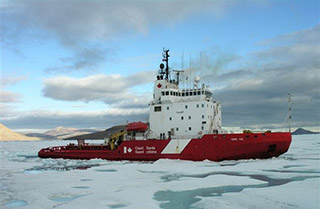With shipping in its Arctic waters more than doubled since 2004 as sea ice declined, Canada needs a comprehensive shipping policy to balance industry needs, maritime safety, the environment and needs of native Inuit communities, says a new report by the Pew Charitable Trusts.
Some passages could see another doubling of maritime traffic by 2020. While the Canadian government recognizes the need, “existing management of Arctic shipping does not sufficiently account for the environmental and social complexity of Canada’s Arctic Ocean,” says the proposal for an “Integrated Arctic Corridors Framework.”
The report proposes a new management structure it calls the Canadian Arctic Corridors Commission, and formal involvement of Inuit communities. The intricate 92,000-mile coastline has 53 communities, and is the scene of some of the most massive wildlife migrations in the world – often at times of peak maritime traffic.
No fewer than seven government studies since 1990 have made more than 170 recommendations for policy reform, the report says, “however, the nation lacks a clear, cohesive vision for Arctic shipping policy, so these recommendations have fallen on agencies with limited resources to carry them out.”
 The Crystal Serenity. Crystal Cruises photo.The Pew paper comes as Canadian coast guard and U.S. Coast Guard officers prepare for the August voyage of the Crystal Serenity, a 781’x105’x25’ cruise ship that will carry 1,700 passengers from Alaska to New York City on a 32-day trip – seen as the inauguration of high-latitude luxury cruising. Operator Crystal Cruises, Century City, Calif., says it has sold out the trip, with cabin prices from $21,500 to $120,000.
The Crystal Serenity. Crystal Cruises photo.The Pew paper comes as Canadian coast guard and U.S. Coast Guard officers prepare for the August voyage of the Crystal Serenity, a 781’x105’x25’ cruise ship that will carry 1,700 passengers from Alaska to New York City on a 32-day trip – seen as the inauguration of high-latitude luxury cruising. Operator Crystal Cruises, Century City, Calif., says it has sold out the trip, with cabin prices from $21,500 to $120,000.
Coast Guard Commandant Adm. Paul Zunkunft has been talking about the Crystal Cruises venture as a signal that the U.S. cannot risk falling behind in its icebreaker capability in the polar regions.
“Every stateroom is filled,” Zunkunft said during a Jan. 13 talk to Center for Strategic and International Studies in Washington, D.C., shortly before the Coast Guard issued its call for designing a new heavy icebreaker. “I reached out to the cruise industry and I said, ‘I hope none of you are thinking about this.’ And they said, ‘Are you kidding me? At these prices and earnings? Absolutely.’”
Much smaller, eco-tourism oriented cruise ships already frequent increasingly open Arctic waters. The summer 2010 grounding of one cruise vessel, the 330’x53’x15’ Clipper Adventurer with 128 passengers is cited in the report. So too is the grounding that same year of the 384’x62’ tanker Nanny, a community resupply ship operated by Coastal Shipping Ltd., Lewisporte, Newfoundland, that was burdened with 2.5 million gallons of diesel fuel. Both are mentioned as examples of increasing risks to people and the environment in a region where ship assist and search and rescue resources are scarce and scattered.
In 2012 the Canadian coast guard launched the Northern Marine Transportation Corridors Initiative (NMTCI) to address shortcomings in Arctic shipping policies. It wants to establish a voluntary system of marine corridors, to better focus personnel and resources to support maritime safety in the region.
“The NMTCI has the potential to be the foundation for a national Arctic shipping policy,” the Pew paper says, “but for this to happen, the corridor initiative must be widened to account for the environmental and social complexity of Canada’s Arctic Ocean.”
A broader plan should include Inuit in policy creation and implementation, and recognize areas they use, along with wildlife habitat and migration corridors, the report says. Among its points:
• Corridors should use targeted routing and site-specific management to reduce impacts on the marine environment by minimizing the overlap of shipping with sensitive marine areas.
• Infrastructure development and contingency planning should match assessed risk levels in each corridor, including worst-case scenarios for oil spills and vessel emergencies.
• Important Arctic passages (bottlenecks and other areas with particular environmental and social significance) will require site-specific management strategies that account for their dynamic environmental and human importance.
• Formal marine protections need to accompany corridor development to ensure the biological abundance of the Arctic exists in perpetuity.
• Management of the network of Arctic shipping corridors should be an adaptive process, responding to environmental variability, new information, and monitoring.




